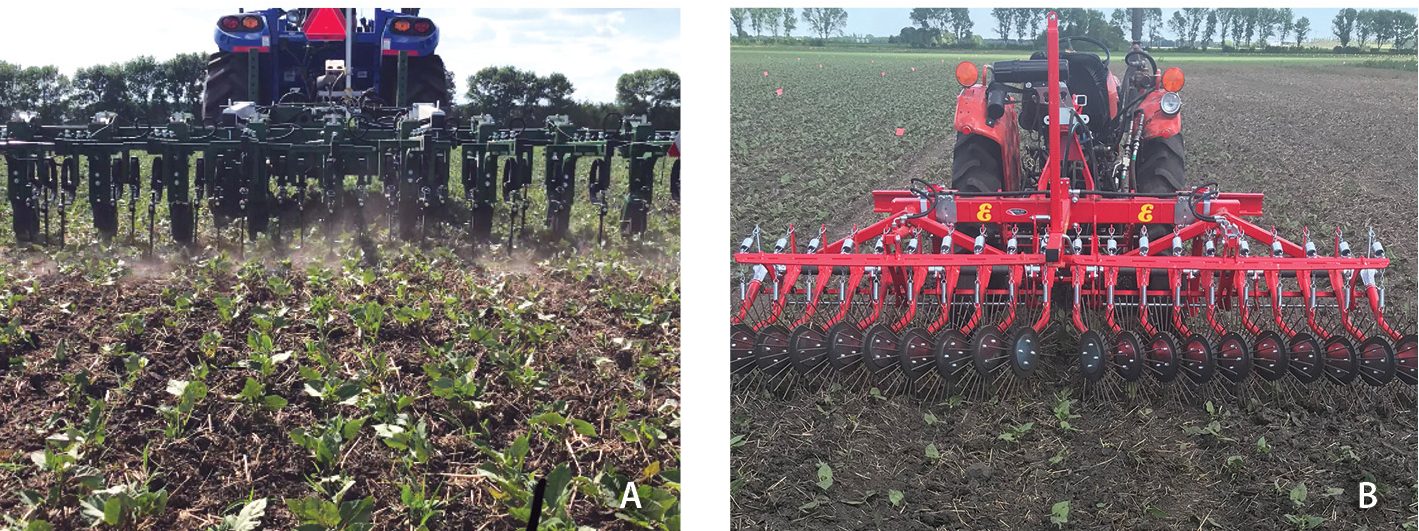Katherine Stanley and Dr. Martin Entz, Department of Plant Science, University of Manitoba
MANAGING WEEDS IN dry beans can present challenges due to their uncompetitive nature relative to other crops. Dry beans have been traditionally grown on wide rows to allow for row-crop cultivation, however, some farmers have begun to grow dry beans in solid-seeded production systems; in narrow rows, which requires a change in weed management strategy. When planted in narrow rows, beans are not as close together in the row, which can reduce crop competition with weeds. While this is somewhat accounted for by increasing seeding rate, weeds remain competitive and there are limited herbicides available for dry bean production. Relying solely on herbicides for weed control can accelerate the development of herbicide-resistant weeds, compromising the long-term suitability of dry beans for narrow-row crop production.
Diversifying weed management tools to create an integrated weed management strategy is important to slow the rate of development of herbicide-resistant weeds, and to maintain an economically viable production system in the long term. Utilizing mechanical and cultural weed control methods, to complement herbicidal weed control can help to achieve this. Recently, new mechanical weed control technology such as the camera-guided inter-row cultivator (Figure 1a) and the rotative weeder (Einbock Aerostar rotation Figure 1b) have been introduced to the Canadian prairies. There is potential for these tools to be integrated into narrow-row crop production systems, reducing herbicide application during the growing season.

This study, carried out in 2018, evaluated the use of these tools integrated with herbicidal weed control in narrow-row navy beans, pinto beans and black beans. Preliminary data from the pinto bean study is discussed in this article.
Windbreaker pinto beans were sown on six-inch rows to a recommended target plant population of 89,000 plants/ ac (22 plants/m2). Shown in Figure 2, treatments included:
- Full herbicide control (full) that consisted of a pre-emergent application of Edge, and two
in-crop applications - Pre-emergent herbicide only (Pre)
- Inter-row cultivation (IRC)
- Rotative weeder (R)
- IRC+R,
- Pre + IRC
- Pre + R
- Pre + IRC + R
- Weedy control
Mechanical weed control timings were applied at the best known timing based on crop and weed staging.

The first year of this study in pinto beans provided interesting insight into the competitive ability of this bean type. Treatments without herbicide had significantly higher weed biomass than treatments that included a herbicide application. There was no significant difference in weed biomass between reduced and full herbicide treatments. The similarities in weed pressure between a full herbicide treatment, and only pre-emergent was also observed in the field (Figure 3).
While there was a slight yield decrease in treatments with no herbicide, this was not significant, despite the higher weed biomass in these treatments (Figure 2). This was also true for the weedy control treatment, despite the fact that the high weed pressure was evident in the field (Figure 4). This would suggest that pinto beans may have a high level of tolerance to weed competition in the field.


The large amount of weed biomass in the mechanical weed control treatments may suggest that weed management needs to occur earlier than when it was applied in this study. The rotative weeder treatments were applied around the unifoliate stage, however having a pre-emergent mechanical weed control treatment, or applying the rotation earlier after emergence may have had better control of weeds while they were still in the white thread stage.
The inter-row cultivator had excellent control of weeds in between the crop rows, however the weeds remaining in the crop row were competitive throughout the remainder of the season. Experimenting with this equipment on slightly wider rows, allowing for more crop plants in the row may increase the competitive ability of the crop, and allow for the use of other tools on the inter-row cultivator such as finger weeders, which will weed right in the crop row (Figure 5).

Despite non-significant yield loss of pinto beans under intense weed pressure, the remaining weeds could cause issues in future crops through contributions to the weed seedbank. Controlling weed seed return through cutting weeds above the crop, either with a swather or novel tools such as the CombCut (Figure 6), may provide opportunities to give the crop more access to light, filling in the canopy and reducing weed seed return to the seedbank.

There are many opportunities to develop integrated weed management strategies. Understanding the utility of the various mechanical tools in addition to cultural and herbicidal weed control will be important to build robust cropping systems that will continue to be profitable in to the future.

